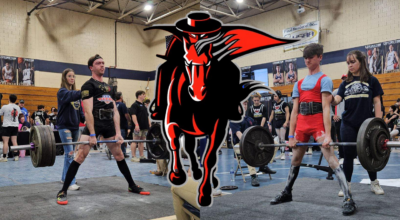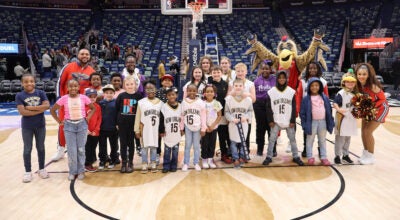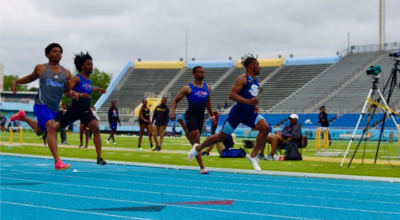Louisiana Sports Hall inductees reflect at opening press conference
Published 8:35 am Friday, August 27, 2021
|
Getting your Trinity Audio player ready...
|
By Matt Vines
Written for the LSWA
The Louisiana Sports Hall of Fame revels in its opportunity to tell lift up its sports legends from all areas of the state – from Lake Providence to Lake Charles, from Shreveport to New Orleans and all areas in between.
But the 2021 induction class has a heavy Baton Rouge lean with five of seven competitive ballot inductees and two of the four contributor honorees having a tie to the Red Stick.
The Baton Rouge tales meandered around the curved walls of the Louisiana Sports Hall of Fame and Northwest Louisiana History Museum on Thursday as the 11-member class was introduced via a press conference aired on Cox Sports Television.
Three of the seven competitor inductees made their mark at LSU, including two of the most decorated individuals in their respective fields.
The induction class includes former LSU track and field coach Pat Henry, LSU defensive tackle Glenn Dorsey, LSU basketball guard Mahmoud Abdul-Rauf, New Orleans Saints receiver Marques Colston, Southern second baseman Rickie Weeks, Nicholls and Southern Miss softball pitcher Courtney Blades Rogers and noted fisherman Bo Dowden.
Other honorees include NFL official Terry McAulay (Dave Dixon Louisiana Sports Leadership Award) and a trio of Distinguished Service Award in Sports Journalism honorees in former NSU Sports Information Director and longtime LSHOF chairman Doug Ireland, trailblazing New Orleans television sports anchor/reporter Ro Brown and The Baton Rouge Advocate sportswriter Sheldon Mickles.
Track and field coach Pat Henry won 27 of his 36 national championships wearing purple and gold, including the first-ever sweep of men’s and women’s NCAA Outdoor titles in just his second season in 1989.
Henry repeated the feat again in 1990 and did it three straight years at Texas A&M (2009-11), cementing his place as one of the most accomplished collegiate coaches in any sport.
“I didn’t have a choice,” Henry joked when asked how he got into coaching. “My grandfather was a football coach at Kansas and Missouri among other places, and my dad was a track coach.
“All four of my brothers became coaches. We just grew up that way. And I’m still doing it (nearly 50 years later) because I still enjoy going to training. I still can get up, so I’m still coaching.”
Glenn Dorsey’s reign at LSU didn’t span the 17 years that Henry’s did.
But Dorsey packed as much as anyone could in his four years as a defensive tackle, winning the grand slam of trophies that included the Outland (best interior lineman), the Lott (defensive player of the year), the Nagurski (player of the year from the Football Writers Association of America) and the Lombardi (embodies the values and spirit of Vince Lombardi).
The two-time All-American returned for his senior year in 2007 and led the Tigers to their second national championship in five seasons.
“I learned a lot from the older guys that were part of that 2003 championship like Kyle Williams and Marcus Spears,” said Dorsey, who had an accomplished nine-year NFL career with the Kansas City Chiefs and San Francisco 49ers after being selected No. 5 overall. “I was a little scared to come back for my senior season, but I enjoyed the people at LSU so much and knew we had a special opportunity to win a national championship. LSU is a place like no other, and I still have LSU decals on my truck out in California.”
Mahmoud Abdul-Rauf’s LSU tenure was even shorter – just two seasons – but the basketball guard made similar memories while piling up the points.
Abdul-Rauf, then named Chris Jackson, set an NCAA freshman scoring record with 30.2 points per game (1988-89) before following up with 27.8 points per game as a sophomore.
The third pick of the Denver Nuggets played nine NBA seasons with nearly 15 points per game before he returned to Baton Rouge to have his No. 35 jersey retired in 2020.
Abdul-Rauf, at age 52, is still getting buckets as he’s playing in the professional 3-on-3 tournament in the Bahamas this weekend and won’t be able to attend the ceremony.
“I started hearing about the possibility of the Louisiana Sports Hall of Fame when I was down in Baton Rouge for the jersey retirement, and it was like a double whammy,” Abdul-Rauf said in a pre-recorded interview. “I’m deeply grateful.
“Even though I’m a Mississippi native, Louisiana really has become my home. They welcomed me with opened arms and supported me.”
The Baton Rouge drum continued to beat as Rickie Weeks made his way to the capital city and Southern University from Altamonte Springs, Fla.
Weeks was a virtual unknown before an “old-time” Southern scout alerted baseball coach Roger Cador after watching Weeks leg out a triple after line driving a ball of a pitcher’s head.
He lit the college baseball world on fire with NCAA Division I career records of .465 batting average and .927 slugging percentage, taking the Baseball America Player of the Year honor and Dick Howser Trophy in 2003.
Before his 14-year MLB career, most with the Milwaukee Brewers, he had to figure out he was among the nation’s best.
“I was at Team USA tryouts, and I was seeing guys from Texas, Stanford, Florida and Florida State – all the big schools,” Weeks said. “I’m here from little ol’ Southern, and I was thinking, ‘Do I hide the name across my chest and put my head down?’
“But I’ve always had confidence in myself, and so I went out there and showed them what I can do, and I made that team. It makes you stick your chest out a little more, and that was the jumping off point of my career. I loved my time at Southern, and it’s about the other players and the people that believed in me.”
Weeks, who was the starting second baseman in 2011 MLB All-Star Game, said he didn’t think he could hit the pitches of this next inductee.
Softball pitcher Courtney Blades Rogers struck out an NCAA record 1,733 batters in 1,261 2-3 innings, including piling up 52 wins for Southern Miss in 2000 en route to a national player of the year honor.
The Golden Eagles had a softball program for only eight years when Rogers transferred to USM from Nicholls, and she took her new program to two Women’s College World Series in her two seasons.
The Baton Rouge native had to go through her hometown LSU Tigers to make each WCWS trip.
“The media made a big deal of me coming back to my hometown, but I didn’t think that it was that big of a deal,” Rogers said. “But when I found out we had to go back to Baton Rouge the second year, I cried because I didn’t think I could beat LSU again to make another WCWS.
“But we did. LSU was one of the programs I wanted to transfer to (after winning the 1998 Southland Conference Pitcher of the Year at Nicholls), but coach Lu Harris-Champer was my softball person, and I followed her from Nicholls to Southern Miss. It was a perfect choice.”
Blades Rogers tallied a 151-34 career record with the help of a jaw-dropping changeup she developed as a junior, and she totaled 77 shutouts and a career 0.97 ERA.
She was voted in the top 11 college softball pitchers of all-time by an NCAA columnist.
Fisherman Bo Dowden knows something about being near the top of his sport as he was voted one of the top 35 anglers by ESPN Outdoors and BASS in 2004.
The Natchitoches native hadn’t won a professional tournament before the 1980 Bassmaster Classic on the St. Lawrence River in New York, but he had a certain feeling going in.
“I felt like I knew more about the area than the other fishermen because they were just darting around in practice,” Dowden said. “I thought that was stupid.
“I achieved the goal of besting some of the best out there. You have to think you’re better than the fish, and that you could catch those critters.”
Dowden’s stringer of 54 pounds, 10 ounces won by more than 10 pounds, the fourth-largest margin of victory to date.
He had three other top-three finishes in a total 14 Bassmaster Classic appearances.
Quiet and unassuming would also describe New Orleans Saints receiver Marques Colston.
Colston fought his way into the NFL Draft as a seventh-rounder out of Hofstra before he rocketed to a Week 1 starter as a rookie that culminated in a 10-year career as the most prolific receiver in franchise history.
But before the 711 catches for 9,759 yards, both Saints records, and a Super Bowl win in 2009, Colston had to get on the field.
“In the first (preseason) camp, I kept getting opportunities to learn while picking up new positions, language and terminology,” Colston said. “I was getting more and more reps, but I was naive to the business of football.
“We got to Week 1, and we’re out at Wednesday practice. And that one receiver position in the huddle was vacant, and I’m looking around to see who would fill it. They told me, ‘What are you standing there for, go get in the huddle.’ That’s how I found out I would be the starter in Week 1.”
After reaching the NFC Championship game in 2006, Colston credited consecutive 7-9 seasons for setting the stage from a motivational standpoint for the 2009 Super Bowl run, which included a 13-0 start.
NFL official Terry McAulay knows something about Super Bowls, serving on the crew for three of them.
The LSU graduate is just one of six officials to work three or more Super Bowls as he worked the playoffs in 17 of his 20 seasons.
While most kids dream of being star athletes, McAulay stood in front of televisions and mirrors practicing his penalty signals.
“When I was watching Super Bowl III as a kid, I was more intrigued by the officials,” McAulay said. “As a high school kid, I approached a group of high school officials after a game and asked them how can I get started.
“I was out at training that summer, and that’s how it started.”
Another LSU graduate Sheldon Mickles earned many of his journalism stripes covering the Saints for 30 years with the Baton Rouge Advocate.
He’s been in Baton Rouge media since 1978 with the afternoon State-Times before joining The Advocate in 1991.
On top of his 17 Super Bowls, Mickles covered the vast majority of Pat Henry’s track and field championships at LSU and nearly all of Colston’s catches.
“I think I even covered one of the Courtney Blades Rogers NCAA Tournament games in Baton Rouge when she struck out something like 20 (in a 13-inning win),” Mickles said, adding that he was happy to cover any sport at any time. “I enjoy writing features and getting to know the people involved, and you could see how great a lot of this class would be when you saw them play.”
Just as Mickles has called Baton Rouge home for more than 40 years, then-sports writer Doug Ireland couldn’t ignore the call of his adopted home of Natchitoches and Northwestern State.
Already a successful sports writer for the Alexandria Town Talk among other places, Ireland couldn’t resist returning to his alma mater as its sports information director.
On top of three decades of accomplished SID work, Ireland spearheaded the Louisiana Sports Hall of Fame as its chairman since 1990 and was a driving force in making the dream of a physical building for the museum come true in 2013.
“I wouldn’t have left sports journalism for anywhere else but here,” said Ireland, adding it’s been a thrill to cover events such as NSU’s 2006 NCAA Tournament upset of Iowa that’s replayed every March. “We didn’t have daily media in Natchitoches, so you had to reach out to various outlets locally, regionally and nationally and accommodate their needs to tell our story.”
Sports broadcaster Ro Brown carries similar weight with his viewership in New Orleans.
As the first on-air African-American talent in New Orleans, Brown started as the sports anchor in 1978 and broadcasted a total of 22 years at WDSU.
Brown earned the Sam Lacy Pioneer Award in 2012 by the Sports Task Force of the National Association for Black Journalists.
“I remember taking a tour of the WDSU studio in 1965 when I was 13 years old,” Brown said. “There were no African-Americans on TV then in that role, and that was the first time I ever thought about being a sportscaster.
“I spent more than 20 years there, and I was where I wanted to be, doing what I wanted to do and doing it for who I wanted to do it for. Older African-Americans I don’t know put there arms around me and tell me how proud they are of me. It’s a big deal to me, but it’s a really big deal to them that I was there doing this in a positive way.”





